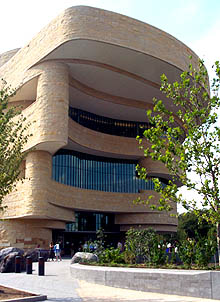By Marc Fisher
There are movements to add museums on Latino and Asian Americans, and Rüdiger Lentz, the veteran German TV journalist who is executive director of the German museum, says he looks forward to the day when the city is home to museums about Polish, Italian and Irish Americans as well.
"Americans should know about all of the ethnicities," Lentz says. "We think there is a lack of information in the American public. They don't know what is German in their own history."
This hyphenated approach to presenting U.S. history stems from the fashion in American academia to pull away from explaining the remarkable and difficult story of how so many different peoples came together in a new kind of nation, focusing instead on deconstructing history into ethnically separate stories that can hardly make sense when each is told in its own building. Germans didn't see their version of history reflected in the Holocaust museum, African Americans saw a gap in the story presented at, for example, the Smithsonian's American History museum, and Indians thought their experience was reduced to a caricature in the most frequently told American narratives.
But when each ethnic group creates its own museum, visitors are left without the tools to put each ethnicity's take on history in any useful context. The National Museum of the American Indian proudly opened in 2004 as the Smithsonian Institution's first museum to abdicate its responsibility to present a narrative that seeks to let visitors question the past, warts and all. Instead, the American Indian museum set a new tone by offering what it calls "self-told histories of selected native communities," allowing, for example, a California tribe to offer a display of artifacts from its gambling casino, with not a word about the economic impact of Indian casinos, gambling addiction or conflicts between the tribe and its neighbors.
The German museum presents a different problem, but one that also undermines the public's ability to trust that curators are at least attempting to present facts that visitors can then interpret as they wish: Although Lentz says he wants to show the good and the bad in German American history, he readily admits that the purpose of the museum is to promote German culture--there's even a kiosk offering travel information on Germany.
"I am dancing on the edge of the volcano," Lentz says. His funding comes mainly from the umbrella group of German American social and fraternal clubs, whose leaders tend to favor a boosterish approach to telling their story.
FYI, Marc Fisher is a conservative columnist who once defended the "Washington Redskins" name as benign and appropriate. That tells you roughly where he's coming from.
I don't recall all the "ethnic" museums I've visited, but I actually agree with Fisher's critique of the NMAI. I said as much when the museum opened and when I visited it.
From what I've seen and read, the NMAI does a good job of probing what it means to be an Indian today. I.e., the conflict between traditional vs. modern viewpoints.
What it doesn't do well is present negative or critical viewpoints. Based on the museum's exhibits, you'd have a hard time putting together a history of the disease, warfare, and government malfeasance suffered by Indians. The information is there, scattered in bits and pieces, but the overall tone is celebratory. Like the German-American museum, it's all very boosterish.
NMAI is the exception
I didn't get this impression from the other Native museums I've visited--for instance, the Southwest Museum in LA. Some exhibits may have been positive and some may have been negative, but the overall approach was neutral. Sure, the tone was respectful and culturally sensitive, but I don't think they hesitated to talk about death or destruction.
Here's where Fisher's screed fails. I've seen Native and ethnic museums that didn't separate their people's stories--that put them into context. If you haven't been to such a museum, it's easy enough to imagine. Think of someone with my critical attitude running the museum, curating the exhibits, or writing the wall copy. You'd get a clash of ideas just as you get in this blog.
All it takes for ethnic museums to work is founders and leaders with the proper attitude. Most already have this attitude, which is why no one except Fisher is criticizing them. Basically he's found two museums he doesn't like and spun that into an attack on hundreds of others.
So Fisher's position--that ethnic museums are doomed to fail and shouldn't even be tried--is stupid and wrong. The evidence proves such museums can work.
No doubt he prefers museums where we celebrate conventional American history and culture. You know, where Indians were happy to give up their savage ways, become good Christians, and sink into the melting pot. Where they're now so assimilated that they cheer for his beloved Redskins.
For more on the subject, see The Feel-Good National Museum: Reviews of the National Museum of the American Indian.


No comments:
Post a Comment